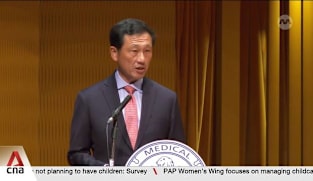Janil Puthucheary on public healthcare capitation funding model
Different methods of funding for healthcare, if designed and implemented well, do not negatively affect quality of service at hospitals. If wastage and unnecessary procedures can be removed, it improves the effectiveness and well-being of healthcare workers, reduces the financing burden of healthcare and can improve the level of service. Senior Minister of State for Health Janil Puthucheary said this in Parliament on Wednesday (May 10) in response to an MP’s questions on the new capitation funding model for public healthcare. Dr Janil said pilot projects on pay-for-performance and bundled payments delivered positive results, leading to better health outcomes without compromising care. However, they did not incentivise the reduction of population-level wastage, meaning that some patients should not become sick in the first place. Capitation funding, on the other hand, aims to incentivise healthcare providers to place greater emphasis on preventive care. Singapore transited to this model from Apr 1 this year. Each of the three healthcare clusters has a population of about 1.5 million residents assigned to them and is paid funding rates based on the age bands of their residents. Dr Janil said the rates are designed so that there is no reduction and in fact a slight increase to the cluster budgets, compared to previous years. As the population gets older, more residents will require higher capitation rates and the clusters will receive higher budgets. He explained how the system is kept flexible so that residents can choose which hospitals they would like to go to.
Different methods of funding for healthcare, if designed and implemented well, do not negatively affect quality of service at hospitals. If wastage and unnecessary procedures can be removed, it improves the effectiveness and well-being of healthcare workers, reduces the financing burden of healthcare and can improve the level of service. Senior Minister of State for Health Janil Puthucheary said this in Parliament on Wednesday (May 10) in response to an MP’s questions on the new capitation funding model for public healthcare. Dr Janil said pilot projects on pay-for-performance and bundled payments delivered positive results, leading to better health outcomes without compromising care. However, they did not incentivise the reduction of population-level wastage, meaning that some patients should not become sick in the first place. Capitation funding, on the other hand, aims to incentivise healthcare providers to place greater emphasis on preventive care. Singapore transited to this model from Apr 1 this year. Each of the three healthcare clusters has a population of about 1.5 million residents assigned to them and is paid funding rates based on the age bands of their residents. Dr Janil said the rates are designed so that there is no reduction and in fact a slight increase to the cluster budgets, compared to previous years. As the population gets older, more residents will require higher capitation rates and the clusters will receive higher budgets. He explained how the system is kept flexible so that residents can choose which hospitals they would like to go to.



















